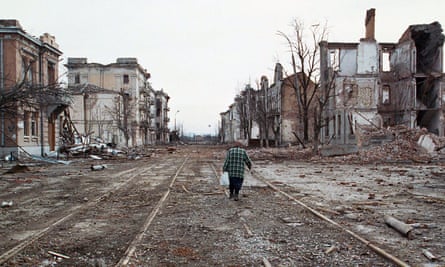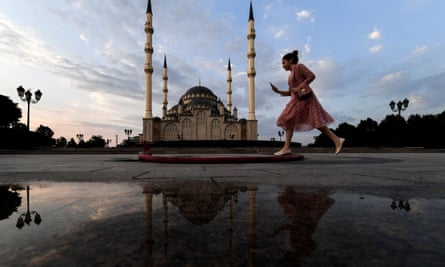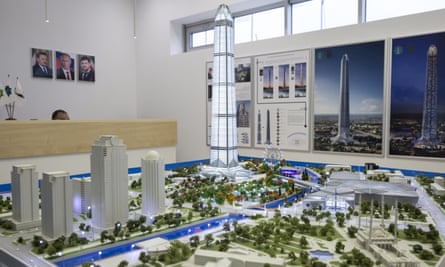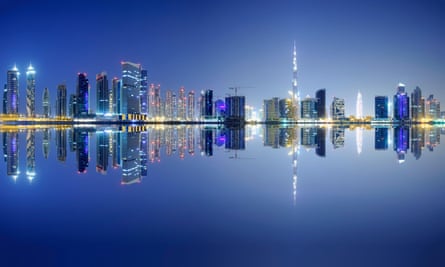Sooner or later, it seems, everything in Chechnya will bear the name Akhmat. The name of the republic’s former leader, Akhmat Kadyrov, now adorns the Russian region’s main mosque, the Heart of Chechnya, its major thoroughfare and its state gallery. When the Egyptian national team arrives in Grozny next week, players will practise at the Akhmat Arena, the home grounds for the region’s football team, the recently renamed Akhmat FC. Ramzan Kadyrov, the region’s strongman, has incorporated his father’s name into his unofficial slogan: “Akhmat is power.”
So it’s no surprise that a planned skyscraper, the latest megaproject in the capital city of Grozny, will be named Akhmat Tower. Billed as the tallest building in Europe at 102 storeys and a staggering cost of $1bn, it is the embodiment of the city’s feverish aspirations to become a kind of Dubai in the North Caucasus.
Beyond the secrecy around the building’s investors there are other hints that this isn’t your average business development.

“It’s not seen as correct to speak out of turn about this project. These are cultural differences, you understand. Permission comes from the top down in the republic,” a representative for the developer told me over coffee recently, declining an interview. Instead, he handed over a glossy magazine called Tall Buildings, sponsored by Akhmat Tower’s architect.
Akhmat Tower reflects the craze for marketing and PR in modern Chechnya, a province sustained by subsidies from Moscow where poverty rates are among the highest in Russia, but where the Grozny-City complex’s skyscrapers with half-filled offices and a luxury hotel have become the symbol of new wealth.
The Chechen government presents Grozny’s carefully-manicured downtown as Exhibit A of the republic’s rebirth following the wars of the 1990s and 2000s that left the capital devastated and hundreds of thousands of civilians dead.

“The tower is a symbol of the defeat of good over evil, of our defeat of the threat of international terrorism,” said Dzhambulat Umarov, a regional minister whose portfolio includes media and nationality politics. “The tower is a symbol of the victory of the ideals of the first president of the Chechen Republic, Akhmat Kadyrov.”
On a recent Thursday afternoon in Grozny, there were just a handful of people on the sunbaked marble walkways by the Heart of Chechnya mosque, styled after the Blue Mosque in Istanbul. Cafes were mostly closed for the Ramadan fast along Putin Prospekt, the main avenue named in honour of the Russian president. A pair of security guards lazed by a memorial officially dedicated to those killed in the fight against terrorism. Everyone is a bit woozy from the lack of food and water, waiting to break their fast with iftar, the evening meal.
The foundation pit lies just across Akhmat Kadyrov Prospekt, right at the heart of the city. At a projected 435 metres (1427 feet), Akhmat Tower will be the tallest building in Europe, erected by a government at its very fringe, embracing a rejection of western liberalism with an ultraconservative ethos that emphasises cohesiveness over individual rights.

In practice, those values have taken a dark turn.
Numerous reports last year indicated that the region’s authorities rounded up hundreds of gay men and subjected them to beatings and torture. The outcry made Kadyrov a household name in the west. Asked about the purges, Kadyrov appeared to take greater umbrage at the idea that there were any gay Chechens than accusations that they had been jailed or murdered.
Before that, he had been accused of practicing collective punishment against the family members of suspected terrorists and of those who protested against his rule, often by burning down family houses.
A number of Chechens spoken to for this article declined to be identified by their full names in a western publication. Even casual critics of the government have been publicly shamed on television, sometimes recanting their views by saying they had been possessed by demons. Journalists and rights workers have been the targets of assassinations and charged with serious crimes.
A young woman named Mariyam, who works in PR and moves between Grozny and another city in Russia, said that she believed the tower was indicative of a misuse of resources that she thought was tied to self-dealing. “Nobody believes that this is what Chechnya needs right now, or if they believe that, then they believe the propaganda,” she said. “But mostly people just try not to stick their necks out and just live. Honestly speaking, I really think most people don’t have any opinion on this tower at all. It’s too far from their lives.”
There isn’t much to see at the moment, just a rectangular foundation pit with pilings blocked off from public view. Construction is active at the Grozny Mall next door, a shopping complex that is expected to serve greater demand than the luxury apartments and offices planned for Akhmat Tower. Already, there are suggestions that construction of the tower has stalled and the 2020 deadline for its construction could be pushed back to 2022 or 2024.

The project points to Kadyrov’s ambition for the city to take on an international veneer, modelled on Dubai, that began with the glass towers of the Grozny-City building complex. A deeply coveted sense of internationalism is also lent by the hiring of a firm led by Adrian Smith, the architect behind Dubai’s Burj Khalifa and the Kingdom Tower in Saudi Arabia.
Asked about the comparison made between the city and Dubai, Elina Bataeva, the director of a state-backed tour developer, said she supported the development in the city but it helped to keep things in perspective. “People do come just to see Grozny-City. A lot of Russians who haven’t been to Dubai like to compare it. I’ve been to Dubai, so I know it’s not quite Dubai,” she said laughing. “But there is something to the city and the people.”

One mystery remains the source of funding. The investors in the tower have not been made public, unlike the Emirati backers for an Islamic university being built downtown, and it is not clear how the building will ever turn a profit.
Originally projected to cost $500m, in 2016 the city’s mayor, Muslim Khuchiyev, revealed that the tower would cost more than $1bn. He said then that the building was entirely financed by private investors rather than government subsidies, but declined to name them, fuelling speculation the list could include state-run companies or funds controlled by the Chechen government.
A person close to the regional government who spoke on condition of anonymity said that much of the current complex at Grozny-City hasn’t been occupied by any businesses, and that current tenants included state-run companies who were placed there by political decision.
The hope, he said, was that the supply for offices space and luxury apartments would eventually create demand.
“If there’s a mini-Dubai here, maybe they will come to it,” he said.
For more on life inside the Russian cities hosting the World Cup, visit Guardian Cities or follow on Twitter, Facebook and Instagram
